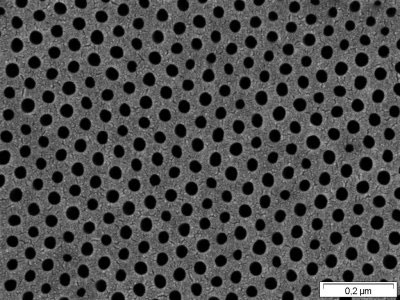| Feb 27, 2013 |
An opening for molecules: Polymer research scientists develop double switchable nanopore membrane
|
|
(Nanowerk News) Pharmaceutical residues in water can pose a danger to humans. Due to the fact that these molecules are soluble in water, there has been increasing evidence of their presence in groundwater for some years. Filtration is often very difficult as these trace substances are so minute. Such trace substances could be removed from the water with the use of new membranes developed by polymer researchers at the Helmholtz-Zentrum Geesthacht ("Double Stimuli-Responsive Isoporous Membranes via Post-Modification of pH-Sensitive Self-Assembled Diblock Copolymer Membranes").
|
|
The newly-developed double switchable membranes could make it possible, in future, to filter different biomolecules, e.g. hormones, proteins, nucleic acids (DNA), according to pore size. This opens up a further possible field of application, in addition to water purification, in the field of medicine e.g. for blood purification.
|
 |
| The production method has already been registered for patent approval: above a look at the 30 nanometer small pores.
|
|
Dr. Juliana Clodt, a scientist from the Institute of Polymer Research at the HZG explains the principle: “The membranes are able to reduce or enlarge the size of their pores through both temperature change and a change in the pH-value”.
|
|
As the size of the pores can also be controlled during the filtration process, fractionated filtrations are also conceivable, whereby firstly the smallest and then increasingly larger molecules pass through the membrane. The minute pores have a diameter of approx. 20 to 30 nanometers. In comparison, a single hair has a diameter of approx. 50 micrometers, which is equal to 50,000 nanometers. Currently Dr. Juliana Clodt explores in further experiments in which the pore size can be tailored.
|
|
In order to produce these block copolymer membranes, the scientists coated pH-sensitive membranes, which were also developed in the Institute of Polymer Research, with a type of adhesive, polydopamin. This adhesive is comparable, from a chemical point of view, with the material used by mussels to adhere to stones under water. Polydopamin is frequently used as an intermediate layer in the field of surface research.
|
|
A further polymer, which reacts to changes in temperature, is applied to the adhesive by means of a chemical reaction. In cold conditions below 25 degrees centigrade, the polymer is present in a swollen state. In warm conditions, at approx. 35 degrees centigrade, it shrinks and the pores open. A membrane is thus obtained which is switchable in two different ways.
|
|
This research was carried out in the scope of the EU project SELFMEM (Self-Assembled Polymer Membranes) which was led by Prof. Dr. Volker Abetz, Director of the Institute of Polymer Research in Geesthacht. The EU project has recently been successfully completed.
|

